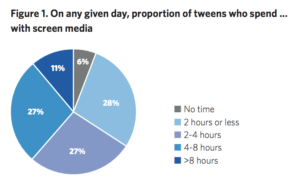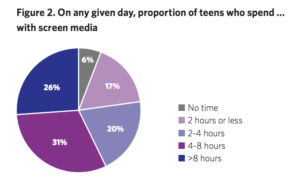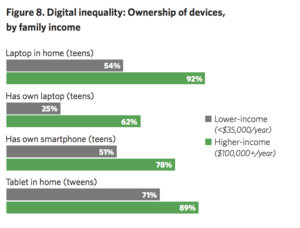Technology has begun to dominate our lives. Older generations have been forced to adapt to the changes it brings, while younger generations are growing up with iPhones, iPads and more. Elementary schools all over America now require students to bring tablets or laptops to class. Many children are being handed iPads before they say their first words. The impact on being raised on technology cannot be properly studied yet because it is still so new to our society. However, it is telling that the engineers who are making these products that have invaded our lives are not letting their children anywhere near the technology. New studies have revealed that lower income, minority group children are spending the most time on screens daily.
In Silicon Valley, parents are implementing no-phone use contracts with their nannies, which requires a nanny to agree to not use any screens – including phones, computers or TV – in front of the child. Many parents who work in the technology industry have decided to get rid of screen time completely for their children instead of just limiting time. Kristin Stecher, a former social computing researcher who is married to an engineer at Facebook said, “Doing no screen time is almost easier than doing a little. If my kids get it at all, they just want it more.” Parents like Kristin understand the addictive nature of technology more than most adults in the United States. Athena Chavarria, who has worked for Mark Zuckerberg for years, has said she is, “…convinced the devil lives in our phones and is wreaking havoc on our children.”
It is obviously ironic that those concerned about their own child’s screen time are the ones creating the technology that will invade millions of other children’s lives. Parents without the awareness of this issue, or the means to hire a nanny to enforce no screen time rules, have kids spending a significant portion of their day on screens. These parents are actually being sent the message that screen time will help their children, and there are valuable educational tools available. The below graphs by Common Sense demonstrate the shocking amount of time tweens and teens are spending on screens in any given day.
When this data is broken down by demographics, inequalities are revealed. According to the Common Sense survey lower-income teenagers spend an average of eight hours and seven minutes a day on screens. Higher-income teenagers spend about five hours and 42 minutes. A Northwestern University study revealed minority children watch 50 percent more TV than white children. These statistics are even more alarming when it is taken into account the inequality of ownership of technology by income. While children from lower-income families are spending more time on screens, they own less screens than higher-income families. The dramatic digital inequality is demonstrated below.
Again, there is no effective way to study the impact growing up with screens has on a child yet. Technology is a continual experiment. However, leading technology executives understand the likely impact and are raising their children to play board games and learn how to socialize – not spend all of their time of screens, if any at all. Instead, they are using children from lower-income families and/or minority groups without the shame knowledge to test this experiment. In as soon as ten years, our society may begin to noticeably see the effects of this inequality play out in higher education enrollment and the work force.



Leave a Reply
You must be logged in to post a comment.